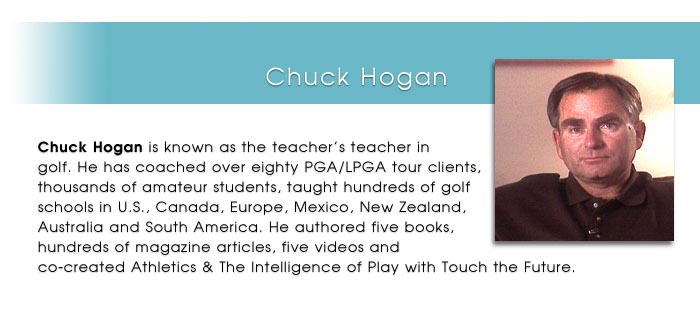
View/Download The Complete Publication
Chuck Hogan
When I was thirteen, I became incredibly nervous during a round of golf. It was shocking. What was overtaking me, dictating my state of mind and body? I couldn’t perform anywhere close to my “normal” level. I was shaking and recreated that experience over and over again. I learned it well.
Years later I began exploring the devil that possessed the body and mind of every athlete who failed to live up to their known performance baseline. I was led to believe that the problem was in technique. Surely, enough hard work and repetition of the perfect mechanical model would bypass any chinks in the psychological or emotional armor. The mechanical models were temporal and faddish. Technique was useful only to the extent that debilitating “pressure” was held at bay.
But, what was the pressure? Surely, sports and games cannot be scary or intimidating. Games and recreation are supposed to be a place to be free, a way to relieve stress. Yet the most successful, intellectual, well-trained and advantaged individuals succumbed to fears and anxieties actually unrelated to the game itself.
Fear of failure? Fear of success? It was just fear – free-floating anxiety. A certain knowing that something must go wrong. And, even if it doesn’t and I succeed today, can I defend my success or was it just a lucky day? For the great majority of my clients and general population of would-be players, there is a little voice which short-circuits the freedom of “flow.” Mistakes are perceived as monumental events and brilliance is chalked off to a stroke of “good luck.”
Why does a 55-year-old CEO of a billion dollar company become a quivering bundle of ragged nerves on the golf course? It turned out that the source of “pressure” is in the haunting of “what will they think of me.” It is little wonder that the fear of public speaking is people’s greatest phobia, greater than even the fear of death.
If we can’t be secure enough to swing at a golf ball, then where and when can we be secure? If a golf course, tennis court, or a soccer field isn’t safe, then where is? Where is a safe playground? Where is the ground solid? The safe ground should be ourselves.
We are designed to evolve bonded and safe at birth, two years, four years, seven, nine to eleven and finally at about fifteen. It was mom, then dad, then family, then society, then earth, and then to ourselves to which our security should be unquestioned. We should be our own playground.
Today, play is an obscure abstraction. We say we are playing, but we have one eye on the ball and one on what might go wrong. The solution is clear while the actions are enormously challenging in today’s environment, dependent on technology (e.g. technique). Security is the essence and foundation of play and the key to unlock the unlimited potentials waiting in the brain of every person.
Do adults play the game? What is the core state? How did we lose it? What is its relationship to the zone? What are we after? Why do we pay so much money to witness performance? How do we become safe and secure?
We need to create ways for children to discover play for the joy of play, to enter into it freely and play the game so that the playing is winning. Don’t set up the game to win or lose. Come up with inventive ways to keep the play going. We also need to allow for individuality. We need to help every person find the way that works best for him or her.
In terms of skill development there can’t be such a thing as failure. There just can’t be. There can only be matching the model or mismatching the model. You either did it like this or you didn’t, and if you didn’t, this is an opportunity to figure out how to get closer next time. The idea of failure has to be removed completely. If adults can’t do this, there is no chance that children are going to be able to do it. If we can’t have fun, they’re not going to have fun. If we’re bored, they’ll be bored. If we’ve got to win to prove we’re having fun, they’ll have to win to have fun. The question is not so much what kids need to do, it is what we need to do?
View/Download The Complete Publication
Chuck Hogan

